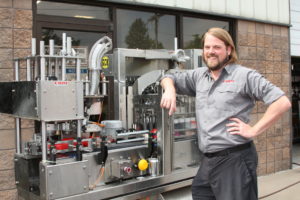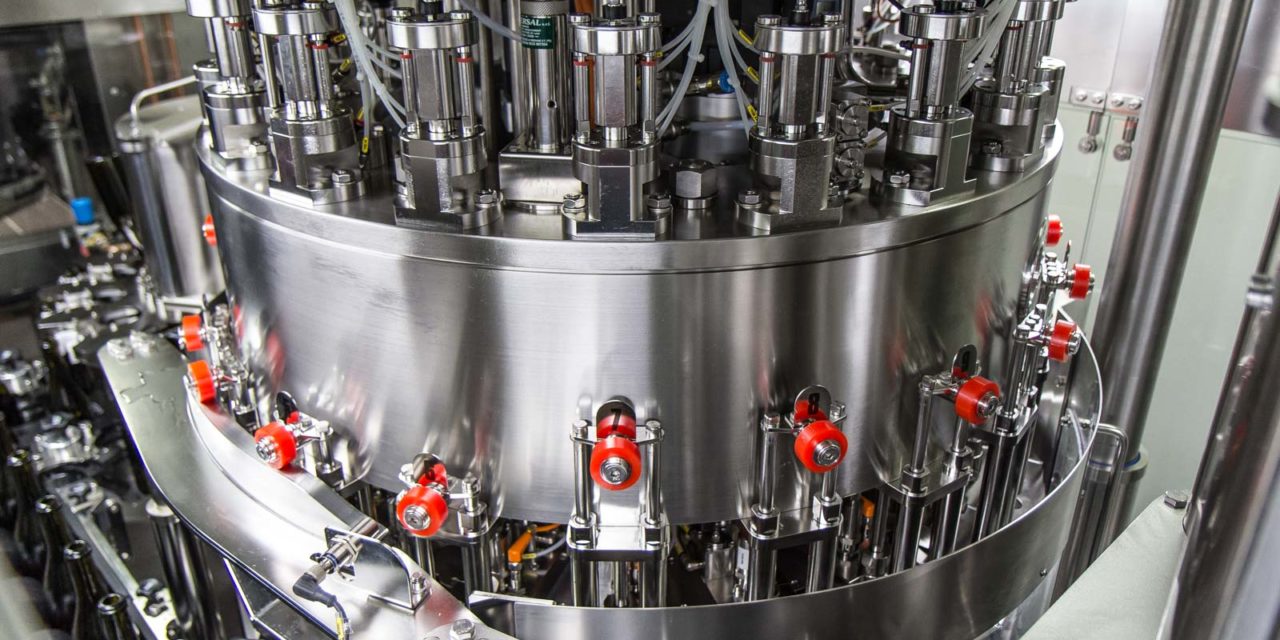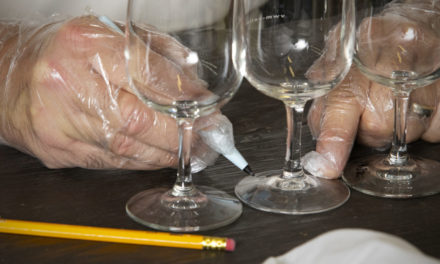Three years ago, Marvin Dunson needed to upgrade the bottling line for his 8,000-case north Georgia winery, Currahee Vineyards. But, given the expense of a new line, he wanted to find a way to spread the cost around. “Why not buy a mobile bottling line?” he thought. That way, he could charge neighboring producers a fee to use his line, generating cash flow and helping to pay for the new equipment.
“I knew they were all small enough that this might be an advantage for them,” says Dunson, whose 12-year-old winery uses muscadines, black Spanish (aka lenoir), and apples to make wine. “No one in the area had this technology, and I thought that would help sell it to them.”
It did. Today, 15 nearby wineries use Dunson’s mobile bottling line, and he’s so busy between his needs and those of his neighbors that he isn’t taking on new customers. In other words, it’s a winning situation all around. He estimates that some 1 million bottles passed through his line in the first 2.5 years of use.

“Everyone involved needs to understand everything that can happen when more than one producer is using the same equipment.” —Andrew Ferguson, Codi Manufacturing
Getting started
Sharing a mobile bottling line isn’t a common solution to problems like Dunson’s, but a variety of producers across the country have gone this route. It happens most often with wineries, but equipment manufacturers say it’s also an option for breweries, cideries, and distilleries. Sharing such equipment can be to everyone’s advantage—as long as everyone involved understands the pitfalls.
“It can be a tremendous success,” says Andrew Ferguson, sales manager for Golden, Colo.-based Codi Manufacturing, which makes complete canning system solutions. “But it’s all about communication: What is a standard CIP procedure everyone will follow? What is a layout that works for everybody’s needs? How will maintenance costs be shared? How will scheduling usage be managed?
“Everyone involved needs to understand everything that can happen when more than one producer is using the same equipment. Because misuse of equipment can cause problems to all parties involved and create stress if not properly communicated.”
Perhaps most important is the idea of “playing well with others.” Remember that this is a business relationship, and business relationships can go awry despite friendships and everyone’s best intentions. Best advice up front: Don’t rely on handshake deals or verbal agreements. Treat it like the business it is. Negotiate, agree, and sign contracts.
The process, say those who’ve done it, can be divided into four steps:
- The economic question: Can you charge enough to pay for the line?
- The scheduling quandary: Can you work everyone in when they need the line and still take care of your own bottling?
- The maintenance commitment: Who will fix something that’s broken? Who will pay for the repairs?
- The size and layout challenge: Will the line fit not only into your facility, but those of your customers?
“There are pluses and minuses, and a lot of people see [buying equipment to share] as a relatively easy way to make lots of money,” says Aaron Belluomini, an account manager for Criveller West in Healdsburg, Calif., which manufactures equipment for processing, bottling, and labeling for wine, beer, spirits, and olive oil. “But as many [operators] fail as succeed. You have to keep in mind that it’s a business—a dedicated business—and you have to know just not how bottling works, but the ins and outs of mobile bottling.”
Financial planning

“You have to keep in mind that it’s a business—a dedicated business—and you have to know just not how bottling works, but the ins and outs of mobile bottling.” —Aaron Belluomini, Criveller
When does it make sense to try the shared approach? First, consider your need to upgrade your own bottling line, whether it’s because of newer technology or increased capacity; to try sharing otherwise may be putting the cart before the horse. If you’re ready, reach out to like-minded producers in your area who may also be candidates to upgrade their bottling line. When planning to share something as crucial as production equipment, transparency is key.
The cost of a standard mobile line varies depending on size, speed, and options, and can include the cost of a trailer to haul the line from job to job. In addition, you’ll need to decide if you want to include can filling in addition to bottles. What about screw caps or other alternate closures? Where does sparkling fit in?
In all of this, answering the financial questions (though they may seem the most daunting) is actually pretty straightforward: How long will it take for the line to pay for itself, and can you afford the time and expense until it does?
Typically, mobile line producers charge their customers 50 cents to $1 per bottle for wine. Matt DiDonato, who works in sales for Prospero Equipment Corp. in Pleasantville, N.Y. (the company’s products include packaging, bottling, and filling lines), says, “You should have an agreement with other local producers. All parties should agree on pricing—including filling fees, transportation expenses, and service/maintenance charges—[before you make the purchase].”
Count on spending between $200,000 and $300,000 for equipment big enough for an 8,000-case winery or comparable brewery (though a winery producing 4,000 to 8,000 cases can spend $80,000 to $100,000 to get going). At Currahee Vineyards, Dunson paid toward the high end, which included a truck to pull the trailer. He estimates it will take two to three years to pay for the equipment, but considers it a sound investment.
On the other hand, Gene Estes, whose Lost Oak Winery in north Texas makes 8,000 cases per year, took the opposite approach. When he outgrew his old bottling line, he hired a third-party—and still uses them almost 10 years later. The cost, he says, is about one-half the price per bottle than if he had bought a new line. “That cost efficiency is one reason I’ve stayed with it,” he says.
Making schedules work
Once all the numbers have been agreed to, the next question becomes: How do you fit everyone in with a minimum of complications?
Belluomini notes that scheduling is about much more than a date on a calendar. Considerations should include: How many times can you run the line in a day? How does travel time, as well as the time to set up the line and take it down, fit in? How many days does each customer need? “It can be a logistical nightmare,” he says. And then there are the unforeseens: “Will an eight-hour day turn into a 15-hour one?”
It takes planning and flexibility—namely, knowing your market area and the needs of your potential customers. In Georgia, Dunson’s customers are close by, similarly sized, and make similar products. He likely encounters fewer problems than in Texas, where Estes’ bottler comes from the Austin area (a couple of hours away).

“All parties should agree on pricing—including filling fees, transportation expenses, and service/maintenance charges.” —Matt DiDonato, Prospero
One best practice? Let customers schedule two or three months ahead, using time slots that accurately reflect their needs, your time, and the setup involved. Then, closer to bottling, refine the schedule for the most accurate picture of what needs to be done, and when.
That same approach applies to maintenance, be it routine or the special set-ups a customer might need. Who will handle routine maintenance? Who will pay for special maintenance related to specific customers? Who is going to clean the equipment? What happens if a hose is clogged and no one notices at the previous job? Or if TCA appears after bottling? How do you account for different producers using different yeast strains? Who is responsible for repairs—both performing them and paying for them—if something breaks during a bottling run?
“Some people like the mechanical part of all this,” says Belluomini, “and if you’re like that or someone who works for you is, then there’s less likelihood of a problem. But if you don’t, and the other producers don’t either, then there’s going to be a problem.”
In this, there isn’t one correct answer, but instead one that works for each cooperative group, taking into account everyone’s situation. Dunson, for example, has a consultant who understands the mechanics involved, and who regularly performs routine maintenance to make sure the little things don’t go wrong. This year, for example, he had 10 nozzles rebuilt.
“You don’t want people to start blaming each other,” says Ferguson. “[These details] need to be documented and agreed upon ahead of time.”
Will it fit?
Bigger is not always better. One producer’s perfectly sized line may be too big for a customer. Or the wrong shape to fit onto a customer’s property. Or not maneuverable enough to squeeze onto the property.
This, says Ferguson, isn’t something everyone thinks about ahead of time. But when the line shows up and there isn’t enough room on the customer’s winery for it to go into operation, everyone loses.
Estes says the van with the bottling line he uses can back up to the high bay door on his loading dock, put down the conveyors, and get to work. The entire setup is air-conditioned—also a plus in Texas—and can handle 2,000 cases per day.
In the end, it’s about cost and benefits. It’s also about steady relationships, honest communication, and reasonable expectations. But if you’re looking for an added revenue stream or a way to balance expenses over time, investing in a mobile line and working with your neighboring producers could be the answer you seek.











